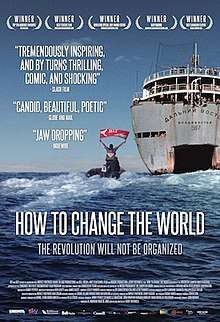How to Change the World (film)
How to Change the World is a documentary film, from writer-director Jerry Rothwell (Deep Water), which chronicles the adventures of an eclectic group of young pioneers who set out to stop Richard Nixon's nuclear bomb tests in Amchitka, Alaska, and end up creating the worldwide green movement with the birth of Greenpeace.
| How to Change the World | |
|---|---|
 | |
| Directed by | Jerry Rothwell |
| Produced by | Al Morrow Bous de Jong |
| Written by | Jerry Rothwell |
| Starring | Robert Hunter |
| Narrated by | Barry Pepper |
| Music by | Lesley Barber |
| Cinematography | Ben Lichty |
| Edited by | James Scott |
| Distributed by | Picturehouse Entertainment |
Release date |
|
Running time | 112 minutes |
| Country | United Kingdom Canada |
| Language | English |
Synopsis
In 1971 a small group of activists set sail from Vancouver, Canada in an old fishing boat. Their mission was to stop Nixon's atomic test bomb in Amchitka, Alaska. Chronicling this untold story at the birth of the modern environmental movement and with access to dramatic archive footage unseen for over 40 years, the film centres on eco-hero Robert Hunter and his part in the creation of the global organization we now know as Greenpeace.
Structured by the five rules of engagement from Hunter's writings.
Cast
- Barry Pepper as Narrator
- Bob Hunter as main character
- Bill Darnel
- David "Walrus" Garrick
- Bobbi Hunter
- Emily Hunter
- Will Jackson
- George Korotva
- Myron McDonald
- Rod Marining
- Patrick Moore
- Ron Precious
- Paul Spong
- Carlie Truman
- Paul Watson
- Rex Weyler
Release and marketing
The documentary first premiered at the 2015 Sundance Film Festival, winning the World Cinema Documentary Special Jury Award for Editing and the Candescent Award.[1][2] A first trailer was released on July 30, 2015.[3]
On September 9, 2015, Picturehouse screened the documentary across 120 U.K. cinemas and 70 in the U.S. (presented with Fathom Events stateside), followed by a satellite Q&A with Rothwell, fashion designer and Greenpeace supporter Vivienne Westwood and daughter of the first president of Greenpeace, Emily Hunter.[4]
Reception
The film received positive reviews. The review aggregator website Rotten Tomatoes reported an 86% approval rating, with a rating average of 8/10.
Dennis Harvey praised the film in Variety noting, "The goldmine of 16mm color footage, whose propagandic value participants were quite cognizant of at the time, is in mint condition, showing the excitement and fun of the movement in its earliest days."[5] Kate Taylor from The Globe and Mail gave the film 3 out of 4 stars, adding that "Whatever you think of Greenpeace's less well-considered antics over the years, How to Change the World is a compelling story of one environmentalist's remarkable combination of prescience, grit and timing."[6] The Toronto Star wrote "Almost a "found footage" movie, it makes excellent use of 1,500 archived 16 mm reels supplemented with fresh interviews and some animation."[7]
Accolades
The film has received accolades.[8]
| Year | Award | Category | Result |
|---|---|---|---|
| 2015 | Sundance Film Festival | World Doc Special Jury Award: Editing | Won |
| Candescent Award | Won | ||
| 2015 | Sheffield Documentary Festival | Best Environmental Documentary | Won |
| 2015 | Sebastopol Documentary Festival | Best Feature | Won |
| 2015 | Portland EcoFilm Festival | Best Feature Film | Won |
| 2015 | Hot Docs | Top Ten Audience Favourite | Won |
| 2016 | 4th Canadian Screen Awards | Best Feature Length Documentary | Nominated |
| Best Editing in a Documentary | Won |
References
- "Sundance Winner's List". Deadline. Retrieved 31 January 2015.
- "Sundance 2015 Winner's List". The Hollywood Reporter. Retrieved 31 January 2015.
- "How to Change the World trailer: Greenpeace's rise examined in new documentary". The Guardian. Retrieved 30 July 2015.
- "Picturehouse Targets U.S. With Documentary 'World'". Variety. Retrieved 4 August 2015.
- Dennis, Harvey. "Sundance Film Review: 'How to Change the World'". Variety. Retrieved 22 January 2015.
- "How to Change the World: Compelling doc charts dramatic rise of Greenpeace". The Globe and Mail. Retrieved 7 August 2015.
- Howell, Peter. "Mini reviews of The Gift, How to Change the World, Diamond Tongues, Cocksure Lads". Toronto Star. Retrieved 6 August 2015.
- "HOW TO CHANGE THE WORLD". Official Website. Archived from the original on 25 November 2017. Retrieved 17 January 2020.